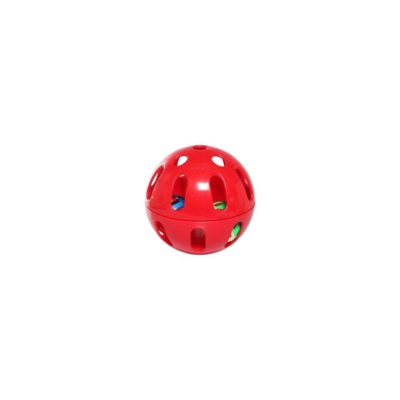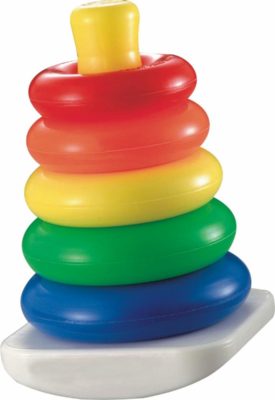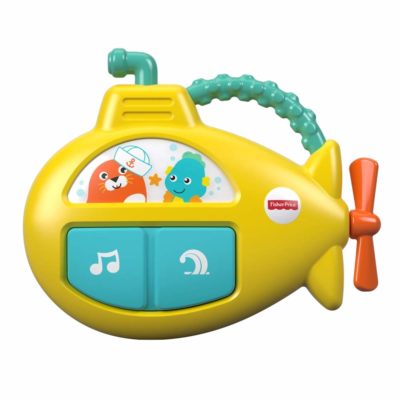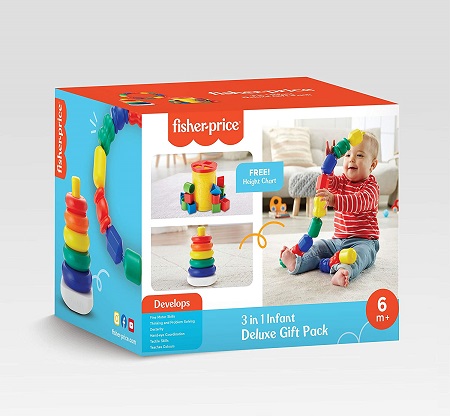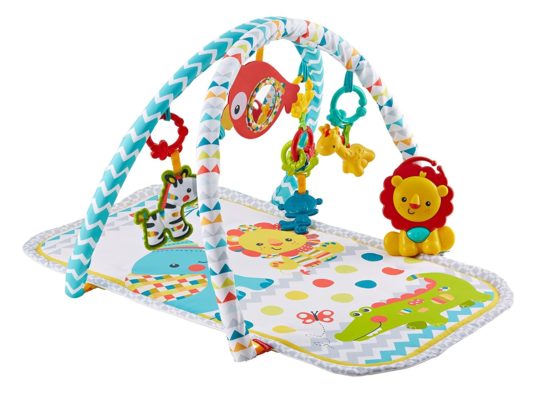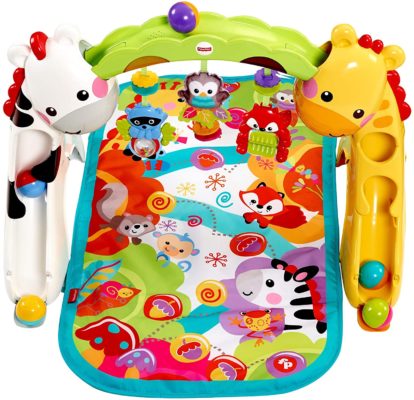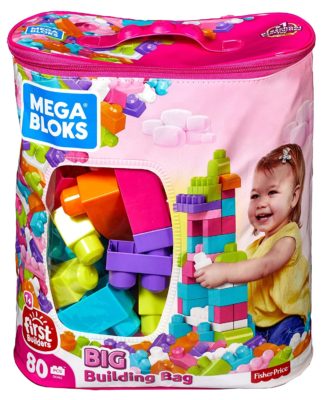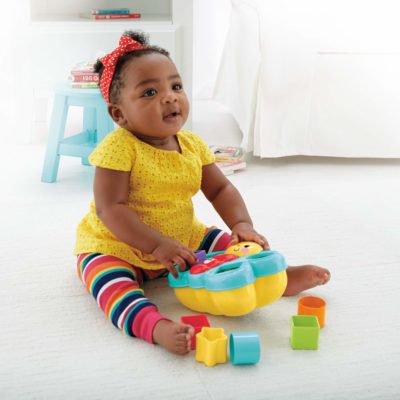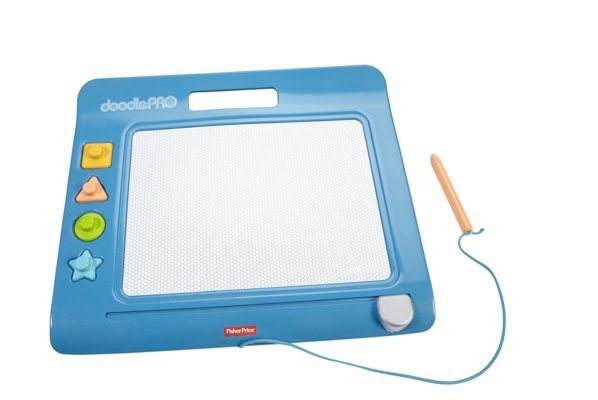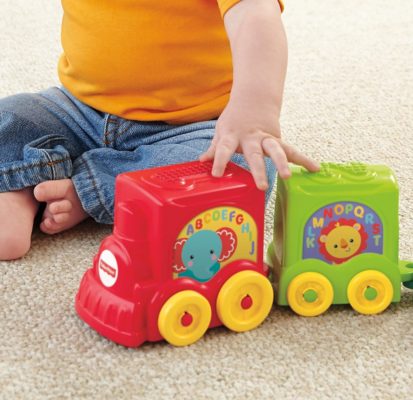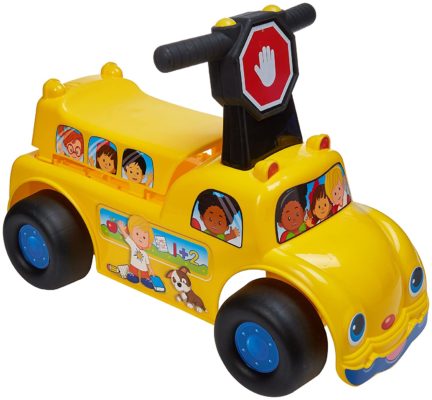Top Fisher Price Toys for Infants and Toddlers
Playing is much more than just a fun way of welcoming your precious little to learn new things. It can be thought of as a means or tool by which he/she explores and understands the world. Most importantly, well-designed and focused toys can be considered as a powerful way of stimulating the development of the key physical, mental, and behavioral aspects of the baby or child.
Every parent needs to be keen on the kind of toys he/she provides for the infant or toddler. Child development is a highly dynamic process that subjects the child through multiple developmental stages, with each characterized by a range of physical, mental, and behavioral abilities. This is reflected in the diversity of toys appropriate in each stage.
This guide will have a comprehensive look at the first two critical stages of human life in light of the associated developmental stages and how you can go about organizing the play environment. The last section will look at some of the best toys for each stage, with a focus on the trusted and leading Fisher-Price brand. Let’s get started.
In this article, we will narrow down your uncompromising search for the best fisher price toys for infants for your little twinkling star. We will cover Age development, Buyer’s Guide, FAQs, Unbiased review of the fisher price toy for infants followed by a conclusion about the best Infant Nail Trimmers.
Top 11 Fisher-price toys for infants
| Product (Best Brands) | Best Price |
|---|---|
Developmental Milestones
The term “developmental milestones” refers to a series of physical, mental, and behavioral gains that are commonly used as hallmarks to describe the different stages of early human development. Although the majority of infants attain various milestones within a designated period of time, there are observable differences among infants and toddlers in terms of how long that period can be.
The differences are largely a result of a myriad of factors such as genetics, environment, culture, and economic status. For instance, it’s a well-known fact that children who are subjected to adverse conditions such as under-nutrition and poor health care are less likely to attain the key developmental milestones in time.
Knowing how children progress through different developmental stages goes beyond knowing which toys to buy for the child. It also plays a crucial role in keeping the child as healthy as possible, as it allows for easy identification of physical and mental conditions. For instance, some conditions such as Cerebral Palsy begin their manifestation as developmental delays, which can be observed from the earliest stages of infant-hood.
Early identification of these disorders is often connected to better treatment plans and outcomes, thus ensuring optimal child health. Now let’s get through the infancy and toddlerhood stages and explore the key developmental milestones you need to be aware of in order to lay a solid ground for understanding how you can provide a focused and safe play environment for your child.
Infancy
Following a normal birth, infants tend to be alert as they start to react to different stimuli from the surrounding environment. Although they are generally immature, key body systems are functional. Infants are generally born with the capacity to carry out key functional processes such as swallowing, sucking, coughing, and excretion.
0-3 months
This stage fully develops hearing organs, while vision needs a few years to fully mature. Recent research exploring infancy and normal child development have shown that newborns have an inert ability to differentiate face-like figures from straight lines. The startle reflex is evident as the infant reacts to sudden movements and a variety of intense stimuli.
You will also observe that the newborn exhibits the grasp reflex, which is basically the propensity to hold objects, especially your finger, once it comes in contact with his/her hand. The newborn also demonstrates a developed sense of smell and taste. This is especially evident in the propensity to turn the head away from strong smells and expression of preferences between sweet and bitter tastes.
When it comes to physical attributes, the infant’s head is larger when compared to the rest of the body. Normal birth-weight lingers between 2.5kg and 4.5kg, whereas the length falls somewhere between 45.7kg and 53.3kg. Following birth, the infant typically loses up to 7% of the total birth-weight before embarking on a weight-gaining journey of an average of 142-170 grams per week.
In terms of communication, crying and fussing come on top of the list. Infants are typically born with a keen sense of touch and sound, especially when the source of stimuli is the mother. Holding them closer to the heart, as well as swaddling, tends to be soothing while shushing sounds also have a calming effect due to the resemblance they bear to typical womb noises.
3-6 months
Beyond the first three months, typical reflexes that were present at birth begin to resolve. Persistence of the primary reflexes often indicates the presence of an underlying neurological condition. Communication also takes a step forward as the infant gradually abandons crying as a primary communication method to adopt more advanced expressions such as social smiling.
This period is also marked by toe and finger awareness, which becomes a huge part of self-entertainment as the infant employs the hand to explore his/her own body and the surrounding. This makes toys such as rattles and mobiles a joy to the infant as well as games such as bye-bye and pat-a-cake. When it comes to parental attachment, things remain normal until 8-9 months where the infant starts exhibiting separation anxiety when away from caregivers
When it comes to vision, the infant demonstrates marked improvement by the end of 4 months. Heightened response to bright objects as well as primary colors is a common trend. At this stage, the infant shows a preference for certain primary colors.
As the infant progresses through the first 12 months, the chest and head circumferences become even as key physical functions begin to mature. By six months, the infant should be able to sit without needing extra support. The succeeding months should see the child learning a variety of body positions and postural transitions such as sitting-kneeling and crawling.
Six months-1 year
By one year, the child should be able to pull up to a standing posture and take the first step without any support.
This stage should also see the infant develop meaningful vocalizations such as “mama,” “dada.” He/she should be able to pick up and manipulate objects such as baby spoons and may try to imitate adult behavior such as brushing hair and turning book pages.
The infant should also develop an understanding of rhythm, which is demonstrated by the appreciation of songs through dance and imitation of singing. Additionally, he should exhibit more complex behaviors such as approval through clapping, and a tendency towards autonomy through resistant behavior such as screaming and kicking.
Toddler Years
Masterly of motor and communication skills take center stage as the rate of physical growth decreases throughout the subsequent two years. The tendency to imitate becomes central in the quest to learn new behaviors and skills, often manifested in the fascination of games such as play-the-house and TV personalities.
They are generally unrelenting, curious, and remarkably enthusiastic to learn new things as they acquire more advanced cognitive and learning abilities. The emotional repertoire expands considerably, including elements such as temper tantrums, hugs, shame, pride, and guilt. Self takes take center stage in their behavioral pattern as they demonstrate an understanding of ownership, though without the willingness to take turns.
Physically, the head circumference increases at the rate of 1.3cm /6 months as the birth weight quadruples over the next 2-3 years. The body takes a more adult-like shape, though the tummy protrudes as the back takes a sway-back posture.
Movement or motor control remarkably progresses from general whole-limb movements (gross) to focused and refined (fine motor) through the next 1-2 years. You will easily notice that the performance on tasks such as drawing progresses from the use of general arm movements to focused and precise manipulation of the fingers and thumb. Considerable physical leaps combined with an insatiable curiosity predispose the toddler to a propensity to wander about. Thus he/she may need extra attention, especially in public.
When it comes to playing, the toddler develops an understanding of object permanence. Thus, he/she develops a fascination for related games such as hide and seek. However, at this stage, there are observable blips in their emotional and cognitive capacity as they demonstrate a reluctance to engage other children in play and follow set rules. The toddler should have the ability to recognize parts and whole objects as well as demonstrate an understanding of their relationships by being able to fit objects into their corresponding spaces.
The language also shows some remarkable leaps as the toddler advances from single-word to complete sentences. By the end of the first 36 months, the toddler is capable of carrying out conversations with adults, although not always intelligible. Understanding the phenomenon of cause and effect is reinforced. However, the toddler may not always be able to understand the risks associated with different situations.
By this time, the child is adept at using ride-on toys, while showing hand dominance. The toddler is also able to identify a variety of primary colors, different shapes, and be able to count from 1 through 20. The vocabulary is limited to 100 words. Thus he/she may be able to memorize simple songs and rhythms.
Age-appropriate toys and play patterns for infants and toddlers
Having considered the key developmental aspects affecting your choice of toys, let’s zoom- in and have a look at the different types of toys in light of their appropriate age groups within the infancy-toddlerhood stages.
Infancy (0-12 months)
Since the infant’s vision is blurry at this stage, he/she typically sees bright items with bold patterns. However, you can still engage the child with different colors, as long as there is a marked contrast among them. As the infant progresses through the stages, other senses mature as well; thus, the toys should be tailored towards engaging the baby in different ways.
Examples……
- Crib mobiles with bright and multiple patterns.
- Mirrors
- Floor gyms
- Dolls or animals with a soft texture.
- Fabric balls
1-2 Years (Toddlerhood)
At this point in time, the toddler tends to be captivated by the phenomenon of cause and effect. This makes toys that respond to the baby’s actions a staple in the play inventory, as they encourage the toddler to effectively explore and experiment with the newly gained motor and cognitive skills. This explains the remarkable fascination in toys with musical buttons and pop-up characters.
Examples……
- 5-piece puzzles.
- Push-toys that combine sounds and pop-up characters.
- Hammering sets.
- Toy vehicles.
- Shapes and sorters.
- Simplified musical instruments such as drums and tambourines.
Older toddlers
At this stage, the child’s play takes a more purposeful turn as he/she develops the necessary motor skills required to complete more complex tasks such as simple puzzles and building blocks. The child’s ability to learn also takes extra steps as the child shows interest in pretend-play, which basically involves mimicking the action and behavior of adults around her.
Activity levels significantly increase at this stage as the child develops new physical and cognitive abilities. Bearing this in mind, you can include ride-on toys which can be propelled by both feet before moving to advanced aids such as the tricycle.
However, push-and-pull toys remain relevant at this stage thus they can still be part of the playroom. Another behavioral milestone you may notice at this stage is that the toddler may intermittently exhibit some gender stereotypes in their play depending on his/her sex. Boys may start to show masculine tendencies such as a preference for toy vehicles while as girls may settle for the opposite.
Examples
- Dolls and animals
- Make-believe play toys i.e. toy phones, tea sets, doll strollers.
- Ride-on toys
- Toy musical instruments.
- Puzzles
General buying guidelines
Having looked at the appropriate types of toys for different age groups, let’s get forward and have a quick look at some of the key elements you need to consider to get the best possible fit for your child.
Age-appropriateness
Your baby’s ability to benefit from a particular toy largely depends on whether he’s enjoying it or not. This is also influenced by whether the child can use it or not. A toy is considered age-appropriate if it can challenge the infant or toddler’s abilities. This becomes even more relevant as the child is developing more physical and cognitive attributes.
However, you need to strike the delicate balance in order to make sure the toy doesn’t frustrate the child. In general, while a toy that doesn’t provide any challenge may easily bore the child, one that’s too sophisticated to use may easily frustrate him thus ultimately leading to abandonment. The previous section sheds more light on the appropriate toys for the different stages within infancy and toddlerhood.
Safety and durability
Credible manufacturers tend to devote considerable time and resources to make sure that the product is as safe as possible for the child. You commonly come across recommendations relating to the best practices when using the toy in question. However, as a parent or caregiver, you still need to meticulously take anything that comes into contact with the infant into consideration.
In the first year of life, the baby will basically bite, drop, bang and suck just about anything he/she has access to. To get rid of the possibility of choking, ensure that any toy involved with your child is no less than 2 inches in terms of diameter. The material in use should also be washable, void of sharp edges and free of long strands that can easily wrap around the neck area.
Additionally, make sure that the materials used in the toy’s construction are safe by checking if the toy or brand is certified by the relevant authorities as safe for daily usage. Lastly, it’s great to make sure that that the toy is light enough so as to avoid any possible injuries which may be caused by drops and throws.
Stimulation
Having identified a particular age-appropriate toy for your child, it proves prudent to consider how much stimulation it provides in light of an intended purpose. If you are in need of something that provides a complete package, it’s always great to combine general-purpose and specialized toys that typically concentrate on a certain aspect of development. However, if you are in for something that your child needs to facilitate the development of a particular area, be sure to consult and get the toy that best addresses the area in question.
Variety
To keep things as interesting as possible, always try to add in an extra measure of variety even in cases where the child needs some focused stimulation. Beyond arousing interest, variety comes with more stimulation, which translates into an enriched learning environment.
Top 11 Fisher-price toys for infants
1. Wobbly fun ball –
The Wobbly fun ball presents a simple but yet highly stimulating toy that’s become one of the most popular for infants within the 3 months-2 years age range. The ball is designed to provide the necessary stimuli to enhance the development of motor control, hand-eye coordination, vision, and cognition.
The ball features a brightly colored exterior with oblong holes purposed to provide anchor points for the child’s little fingers. This allows the child to handle the ball in space using one or both limbs, thus allowing him to work on both gross and fine motor skills. The interiors feature a set of balls with bells aimed at providing the much-needed tinkling sound in order to keep things interesting for the infant.
- Dimensions: 17 x 17 x 17 cm, 6-7 inches diameter.
- Weight: 378g.
- Type: Sensorimotor.
- Key benefits: Enhancing gross and fine motor control, hand-eye coordination, and Audio-visual development.
- Appropriate age: 3 months and above.
- Primary Material: ABS Plastic.
- The ball is efficiently designed to provide early gross and fine motor control training.
- – It comes with a reasonable variety of stimuli to keep the baby as interested as possible.
- – Durable: It is built with highly reliable ABS plastic.
- – It is generally safe for regular unsupervised usage.
- Edges of the ball are sharp and can hurt the baby easily.
2. Fisher-Price Brilliant Basics Rock-a-Stack –
The Rock-a-stack provides another brilliant invention that has a lot to offer as far as normal gross and fine motor infant development is concerned. As the name suggests, it consists of a set of plastic rings that can be stacked on top of each other and a base that is attached to a central plastic anchor.
The toy has so far proven to be a great tool for 6-12-month-old infants as they are developing some more advanced cognitive abilities such as recognizing shapes, colors and spatial relationships between objects.
- Size: 29 x 26.5 x 25 cm.
- Weight: 349g.
- Type: Sensorimotor.
- Key benefits: Encouraging hand-eye coordination, fine and gross control, visual stimulation, recognizing shapes and sizes, understanding spatial relationships between objects.
- Appropriate age: At least 6 months.
- Primary Material: ABS Plastic.
- It provides a great tool for challenging the infant’s gross motor control and object manipulation.
- – It stimulates the child’s ability to recognize shapes, sizes, and colors.
- – Built with highly resistant ABS plastic material, thus able to withstand the inevitable drops and throws.
- – Completely safe within and outside the suggested age groups.
- While washing the rings to maintain hygiene the water gets filled inside.
3. Fisher-Price On-the Go musical Submarine –
The Musical Submarine provides a wonderful play tool tailored towards enhancing audio perception, vision, and fine motor skills. It is simple in design but yet capable of working on the complex aspects of the infant’s cognitive development. Bright colors, colorful lights, a wide array of sounds, a series of buttons, and a spinning propeller allow for visual, audio, touch, and fine motor stimulation. Let’s have a look at the key features before we jump into the related pros and cons.
- Size: 12.7 x 12.7 x 12.7 cm.
- Weight: 99.8g.
- Type: Sensorimotor.
- Key benefits: Visual-audio stimulation, fine motor skill development.
- Appropriate age: At least 3 months.
- Material: ABS Plastic.
- It provides a comprehensive tool for the stimulation of cognitive abilities such as sound recognition and vision.
- A great tool for enhancing the understanding of cause and effect.
- Safe and highly engaging for an infant in the suggested age range.
- It‘s limited when it comes to gross motor control enhancement.
4. Fisher-Price 3-in-1 Infant Deluxe Gift Pack –
Fisher-Price is a well known and reliable brand for toddlers and infants gears and clothing. The brand also supplies preschool kits for toddlers.
Its products are made from kids-friendly material. The Fisher-Price 3-in-1 infant deluxe gift pack is ideal for keeping the child busy playing games and interactive activities.
- The product includes three engaging games – stack, sort, and link that encourages children to learn shapes, colours and master tactile skills.
- It comes in attractive colours.
- The toy is light in weight for the toddler to carry around the house.
- It makes a perfect gift item.
- It is compact and easy to store.
- It can be used by six months to 5 years old kids.
- It is a multipurpose learning toy.
- No cons were observed.
5. Fisher-Price Colorful Carnival 3-in-1 Musical Activity Gym –
The Carnival furnishes one of the best tools you can use to enhance your child’s limb and postural control, as well as other equally important cognitive abilities such as vision, and audio perception. It consists of a padded mat and two overhead arches that provide attachments to six toys, and a musical lion with a maximum play-time of 10 minutes.
The setup allows the child to play in a variety of positions including prone, supine and sitting. This allows stimulation in a variety of postural orientations.
- Size: 50 x 81 x 41 cm.
- Weight: 912g.
- Type: Sensorimotor stimulation toy.
- Key benefits: Postural control, Gross and fine motor limb control, and visual-audio stimulation.
- Appropriate age: At least 3 months.
- Material: Fabric and ABS Plastic.
- It proves an excellent toy for fostering postural control by challenging the infant in a variety of positions.
- It provides comprehensive auditory stimulation
- Highly comfortable and safe for the child.
- It has a wider appropriate age range.
- The mat should have had more cushion for more comfort.
6. Fisher-Price Newborn to Toddler Play Gym –
This toddler play gym combines motor control and sensory stimulation through a rather comprehensive array of audio-visual toys. It is quite similar to the previous toy by design, only that it comes with a more comprehensive set of toys aimed at providing a much broader stimulation range. Let’s take a look at what it has to offer in terms of features.
- Size: 66 x 80 x 47 cm29 x 26.5 x 25 cm.
- Weight: 1.7kg.
- Type: Sensorimotor.
- Key benefits: Fine and gross motor control, visual stimulation, audio stimulation.
- Appropriate age: At least 2 months.
- Primary Material: Cotton Fabric and ABS Plastic.
- Superior in terms of stimulating gross and fine motor control for infants and younger toddlers.
- It features a comprehensive set of visual stimulation tools.
- Generally safe to use and has a wider appropriate age range.
- The width is small of the mat.
7. Fisher-Price First Builders Big Building Bag –
A set of building blocks can prove a wonderful tool when it comes to enhancing your toddler’s motor control, understanding of shapes, spatial relationships, colors, and pattern recognition. This pack affords everything a building block set needs through a thorough provision of colors and sizes. Let’s take a look at the key specs.
- Size of pack: 30.5 x 15.2 x 35.6 cm.
- Weight (the whole pack): 454g.
- Quantity: 70 building blocks and one detachable wheelbase.
- Type: Motor and cognitive development toy.
- Key benefits: Fine motor control enhancement, pattern recognition, problem-solving, visual stimulation.
- Appropriate age: At least 12 months.
- Primary Material: ABS Plastic.
- It proves a remarkable tool for enhancing early creativity and problem-solving skills.
- It provides a great feature set for developing advanced fine motor skills and hand-eye coordination.
- Safe and highly gratifying for kids within the recommended age range.
- Durable material.
- no such cons were found.
8. Fisher-Price Sort N Spill Butterfly –
This is another great tool for toddlers who are beginning to understand shapes with a moderately advanced fine motor control capacity. The package consists of a butterfly-shaped base, which features an array of differently shaped slots and a variety of shapes that can fit into those slots. This arrangement tells a lot for the toy’s main purpose, which is shape recognition and hand-eye coordination. Let’s get into the specifics.
- Size 20.3 x 10.2 x 16.5 cm
- Weight: 318g.
- Quantity: A multi-colored array of 6 pieces (shapes) and one base.
- Type: Cognitive and motor development.
- Key benefits: Fine motor stimulation, hand-eye coordination.
- Appropriate age: At least 2 years.
- Material: ABS Plastic.
- Superior at enhancing object permanence and three-dimensional spatial relationships.
- Great at improving hand-eye coordination.
- Safe and durable.
- It’s limited to fine motor and cognitive skills development.
9. Fisher-Price Doodle Pro Slim –
The Doodle Pro slim provides a helpful drawing tool, which is a way of encouraging the toddler’s cognition as well as fine motor/physical abilities. The toy consists of a magnetic screen and a drawing stylus which is attached to the plastic frame. This might just be the perfect tool for giving your child the first steps into the world of writing while furthering his ability to control and manipulate smaller objects in space.
- Size: 38.1 x 6.4 x 33 cm.
- Weight: 9.07g.
- Type: Cognitive and fine motor development.
- Key benefits: Fine motor stimulation, hand-eye coordination, shape recognition and drawing.
- Appropriate age: At least 1 year.
- Primary Material: ABS Plastic.
- It provides for a focused way of enhancing fine motor skill development.
- It provides a highly practical way of understanding different shapes and other written characters.
- Well-designed and efficient stylus.
- Safe, light and durable.
- quality is not that good.
10. Fisher-Price Stack & Roll Choo Choo –
The Roll Choo Choo furnishes another great example for enhancing motor control, problem solving skills and general understanding of physical patterns. The multi-colored design allows for visual stimulation while maintaining its attractive properties for the toddler. Let’s spend a few moments on the associated key features.
- Size: 11 x 22.9 x 16.6 cm
- Weight: 4.54g.
- Type: Cognitive and fine motor development toy.
- Key benefits: Fine motor stimulation, hand-eye coordination, understanding three dimensional shapes and problem solving skills.
- Appropriate age: 6 months to 2 years.
- Primary Material: ABS Plastic.
- Easy to handle and great for improving fine motor skills.
- Helps with stimulating and improving the child’s problem solving skills and understanding of spatial object relationships.
- Durable.
- Quality could have been better
11. Fisher-Price School Bus Ride-on Vehicle –
Fisher Price comes on board with this delightful ride-on toy which is aimed at enhancing your toddler’s general dynamic physical ability while keeping things as fun and interesting as possible. It’s incredible design makes it one of the most popular toys on the market. Let’s take a closer look.
- Size: 48.3 x 24.1 x 21.6 cm.
- Weight: 1.25kg.
- Type: Gross and fine motor development.
- Key benefits: Dynamic gross motor control stimulation and development, fine motor skills.
- Appropriate age: 1-2 years.
- Primary Material: ABS Plastic.
- It provides for both fun and extremely effective tool for enhancing gross and fine motor control.
- Reliable and durable construction.
- Generally safe for the suggested age range due to the wide base of support and low center of gravity (short height)
- No such cons were found.
Frequently Asked Questions
1. What’s the best toy for infants’ gross motor development?
In general, there is no single best toy for enhancing motor development as needs may defer depending on a variety of factors. This makes it imperative for you to consider various factors such as the child’s actual age, abilities, and other environmental factors.
2. Which toys are great for enhancing problem-solving skills in toddlers?
Problem-solving skills can be improved by a variety of toys including simple puzzles that may come in different forms such as shapes, building blocks and a variety of fun games aimed at challenging the child to read and solve simple problems.
3. What if my child’s milestones are delayed, do I stick to the guidelines or choose the toy depending on his/her specific needs?
In this case, be sure to take the child to a health care professional such as a Doctor or Physiotherapist for an assessment and subsequent recommendations on how you can embark on a focused play program to help the child achieve the necessary milestones.
Conclusion
Buying the best Fisher price toy for your infant or toddler is mostly a matter of understanding how a child progresses through the first 2 years of life and identifying the most applicable toy depending on the age and abilities of your child.
A solid understanding of the key developmental milestones lays the ground for understanding the things you need to look for in light of your child’s age, which in turn guides you through to the best possible toys on the market. This guide seeks to provide a fairly comprehensive discussion on each of the crucial aspects before plunging into the models and brands available on today’s market. All the best as you pursue the best toy companions for the little but special one!





